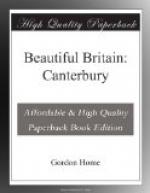a lofty artificial mound, now known as the Dane John—another
form of the familiar donjon. The Romans called
it Durovernum, a name perhaps derived from the British
Derwhern, and although their historians are curiously
silent in regard to the place there cannot be any
doubt that the town rose to great importance in the
later years of the four centuries of the Roman occupation
of Britain. A glance at a map of the Roman roads
in Kent shows Durovernum as a centre for five great
ways leading from the coast towns of Portus Lemanis
(Lymne), Portus Dubris (Dover), Portus Ritupis (Richborough,
near Sandwich), Regulbium (Reculver), and also the
Isle of Thanet, and from this important centre the
Watling Street ran straight to Londinium. These
roads all converge upon the spot where the River Stour
became a tidal estuary and where it was fordable,
and all who arrived or departed from the ports nearest
to Gaul would therefore of necessity pass that way.
Another indication of the size of the town is found
in the five Roman burial-places discovered close to
Canterbury, and if anything else were needed it is
only necessary to look at the walls of St. Augustine’s
Abbey and many other buildings of the Middle Ages
to see the large quantities of Roman material then
available. Wherever any excavation has taken place
in the heart of the present city, the foundations of
Roman buildings with tesselated pavements and quantities
of pottery, small objects of domestic use, and coins
have been brought to light. These remains are
all far beneath the present surface, a most significant
fact in relation to the transition period between
Roman and Saxon Canterbury.
The Romans having finally abandoned Britain early
in the fifth century, the invasions of the Anglo-Saxons
began to take a permanent form, and the Jutes gained
possession of the south-eastern corner of England.
During the period of struggle between the rival groups
of invaders Durovernum must have been entirely abandoned
by the Britons, and the conquerors, having reduced
the city to a shapeless ruin, appear to have allowed
it to become over-grown to such an extent that when,
after a lapse of perhaps a whole century, the town
was rebuilt, no attempt was made to dig down to the
former surface. The new buildings therefore arose
with their foundations some feet above the original
level of the Romano-British city. So complete
was the gap between the destroyed Durovernum and the
Saxon town which eventually grew up that men had had
time to forget the old name, and, finding it necessary
to invent one, called it Cantwarabyrig, which meant
the city of the men of Kent. This title reveals
the fact that the new settlers had by this time fixed
their limits in Kent, and that they had found this
site at the junction of all the Roman roads the most
convenient for their capital. It was probably
not until Ethelbert had begun to reign in 561 that
Canterbury became the most important place in Kent,
and at that time the site of the Cathedral was outside
the town walls. Ethelbert, it should be mentioned,
had extended his power so far beyond the confines
of Kent that he had authority as far north as the
Humber, and Bede writes of “the city of Canterbury,
which was the metropolis of all his dominions.”




